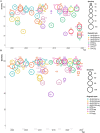Serological diagnosis of cysticercosis in humans and pigs: status, limitations, and prospects
- PMID: 40735286
- PMCID: PMC12303815
- DOI: 10.3389/fvets.2025.1558555
Serological diagnosis of cysticercosis in humans and pigs: status, limitations, and prospects
Abstract
Cysticercosis is a neglected zoonosis caused by Taenia solium, which involves pigs as intermediate hosts, leading to pig cysticercosis (PCC). Humans are the only definitive hosts, harbouring the mature tapeworm in the small intestines, but they can also act as intermediate hosts upon accidental ingestion of eggs, resulting in human cysticercosis (HCC), called neurocysticercosis (NCC) when the cysts lodge in the central nervous system. Diagnosis of HCC/NCC in humans is based on imaging technologies and serology. The gold standard method for PCC diagnosis is the full carcass dissection and recovery of cysts. However, tongue palpation and meat inspection are the most widely used methods in endemic countries. These methods are specific at the genus level but cannot distinguish mixed infection from other taeniids and are not sufficiently sensitive in pigs with low infection. Available serological tests for human and pig infection are based on parasite-specific immunoglobulin G (IgG). Still, most tests are either cross-reactive with other taeniids or not sensitive enough for single or inactive cysts, particularly for NCC patients. Here, we compare various serological techniques for PCC and NCC published since 2000 and discuss the benefit of IgE-based serodiagnosis as a potential alternative to traditional serology. Considering the diagnostic limitations described above and the need to identify endemic areas to prevent transmission between humans and pigs and monitor control efforts, the development of more sensitive and specific serological tests, followed by a field-applicable point-of-care (POC) test for cysticercosis, is of the utmost importance.
Keywords: IgE; Taenia solium; cysticercosis; human; pig; serological tests.
Copyright © 2025 Hossain, Shabir, Ngwili, Thomas and Falcone.
Conflict of interest statement
The authors declare that the research was conducted in the absence of any commercial or financial relationships that could be construed as a potential conflict of interest. The author(s) declared that they were an editorial board member of Frontiers, at the time of submission. This had no impact on the peer review process and the final decision.
Figures


Similar articles
-
Cestode larvae excite host neuronal circuits via glutamatergic signalling.Elife. 2025 Jul 4;12:RP88174. doi: 10.7554/eLife.88174. Elife. 2025. PMID: 40613653 Free PMC article.
-
Neurocysticercosis in a Non-Endemic Region: A Retrospective Cohort Study at Sheikh Khalifa Medical City (SKMC), Abu Dhabi, UAE.Cureus. 2025 May 30;17(5):e85082. doi: 10.7759/cureus.85082. eCollection 2025 May. Cureus. 2025. PMID: 40585698 Free PMC article.
-
Sexual Harassment and Prevention Training.2024 Mar 29. In: StatPearls [Internet]. Treasure Island (FL): StatPearls Publishing; 2025 Jan–. 2024 Mar 29. In: StatPearls [Internet]. Treasure Island (FL): StatPearls Publishing; 2025 Jan–. PMID: 36508513 Free Books & Documents.
-
The societal cost of Taenia solium cysticercosis in Tanzania.Acta Trop. 2017 Jan;165:141-154. doi: 10.1016/j.actatropica.2015.12.021. Epub 2016 Jan 3. Acta Trop. 2017. PMID: 26756713
-
Signs and symptoms to determine if a patient presenting in primary care or hospital outpatient settings has COVID-19.Cochrane Database Syst Rev. 2022 May 20;5(5):CD013665. doi: 10.1002/14651858.CD013665.pub3. Cochrane Database Syst Rev. 2022. PMID: 35593186 Free PMC article.
References
-
- WHO . Global report on neglected tropical diseases 2024 (2024). 86 p.
-
- CDC . Neglected parasitic infections in the United States (2020) Available online at: http://www.cdc.gov/parasites/npi.html
-
- WHO . WHO estimates of the global burden of foodborne diseases: foodborne diseases burden epidemiology reference group 2007–2015 (2015). 265 p.
-
- WHO . Taeniasis/Cysticercosis (2022). Available online at: https://www.who.int/news-room/fact-sheets/detail/taeniasis-cysticercosis
Publication types
LinkOut - more resources
Full Text Sources

